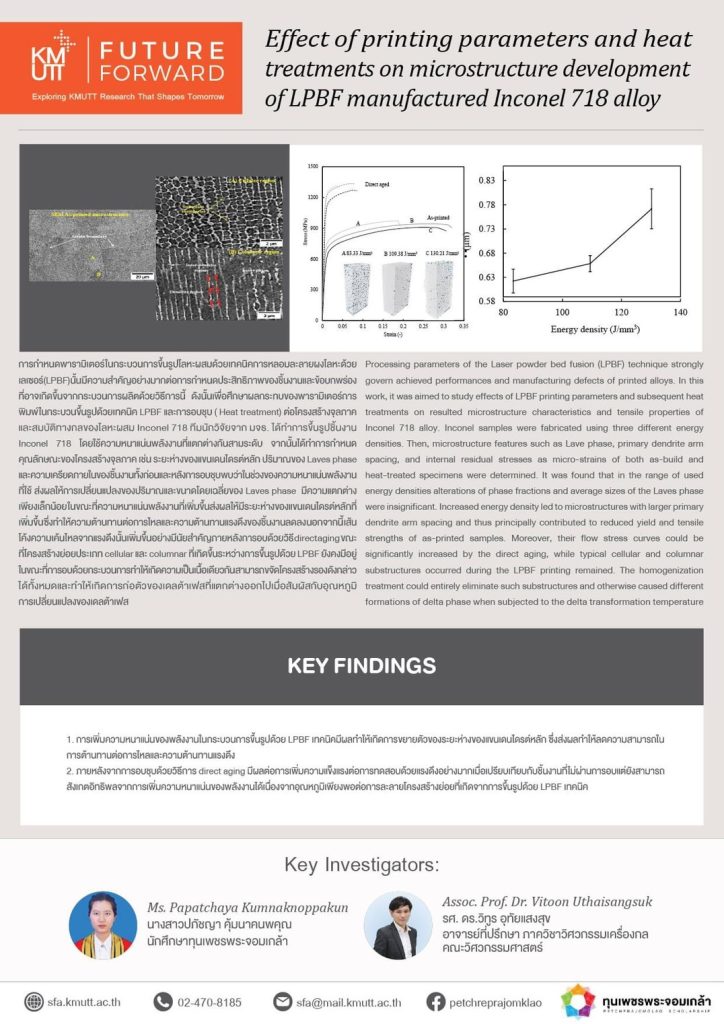การกำหนดพารามิเตอร์ในกระบวนการขึ้นรูปโลหะผสมด้วยเทคนิคการหลอมละลายผงโลหะด้วยเลเซอร์ (LPBF) นั้น มีความสำคัญอย่างมากต่อการกำหนดประสิทธิภาพของชิ้นงานและข้อบกพร่องที่อาจเกิดขึ้นจากกระบวนการผลิตด้วยวิธีการนี้ ดังนั้นเพื่อศึกษาผลกระทบของพารามิเตอร์การพิมพ์ในกระบวนขึ้นรูปด้วยเทคนิค LPBF และการอบชุบ (Heat treatment) ต่อโครงสร้างจุลภาคและสมบัติทางกลของโลหะผสม Inconel 718 ทีมนักวิจัยจาก มจธ. ได้ทำการขึ้นรูปชิ้นงาน Inconel 718 โดยใช้ความหนาแน่นพลังงานที่แตกต่างกันสามระดับ จากนั้นได้ทำการกำหนดคุณลักษณะของโครงสร้างจุลภาค เช่น ระยะห่างของแขนเดนไดรต์หลัก ปริมาณของ Laves phase และความเครียดภายในของชิ้นงานทั้งก่อนและหลังการอบชุบ พบว่าในช่วงของความหนาแน่นพลังงานที่ใช้ ส่งผลให้การเปลี่ยนแปลงของปริมาณและขนาดโดยเฉลี่ยของ Laves phase มีความแตกต่างเพียงเล็กน้อย ในขณะที่ความหนาแน่นพลังงานที่เพิ่มขึ้นส่งผลให้มีระยะห่างของแขนเดนไดรต์หลักที่เพิ่มขึ้น ซึ่งทำให้ความต้านทานต่อการไหลและความต้านทานแรงดึงของชิ้นงานลดลง นอกจากนี้ เส้นโค้งความเค้นไหลจากแรงดึงนั้นเพิ่มขึ้นอย่างมีนัยสำคัญภายหลังการอบด้วยวิธี direct aging ขณะที่โครงสร้างย่อยประเภท cellular และ columnar ที่เกิดขึ้นระหว่างการขึ้นรูปด้วย LPBF ยังคงมีอยู่ ในขณะที่การอบด้วยกระบวนการทำให้เกิดความเป็นเนื้อเดียวกัน สามารถขจัดโครงสร้างรองดังกล่าวได้ทั้งหมดและทำให้เกิดการก่อตัวของเดลต้าเฟสที่แตกต่างออกไปเมื่อสัมผัสกับอุณหภูมิการเปลี่ยนแปลงของเดลต้าเฟส
Processing parameters of the Laser powder bed fusion (LPBF) technique strongly govern achieved performances and manufacturing defects of printed alloys. In this work, it was aimed to study effects of LPBF printing parameters and subsequent heat treatments on resulted microstructure characteristics and tensile properties of Inconel 718 alloy. Inconel samples were fabricated using three different energy densities. Then, microstructure features such as Lave phase, primary dendrite arm spacing, and internal residual stresses as micro-strains of both as-build and heat-treated specimens were determined. It was found that in the range of used energy densities alterations of phase fractions and average sizes of the Laves phase were insignificant. Increased energy density led to microstructures with larger primary dendrite arm spacing and thus principally contributed to reduced yield and tensile strengths of as-printed samples. Moreover, their flow stress curves could be significantly increased by the direct aging, while typical cellular and columnar substructures occurred during the LPBF printing remained. The homogenization treatment could entirely eliminate such substructures and otherwise caused different formations of delta phase when subjected to the delta transformation temperature
𝗞𝗘𝗬 𝗙𝗜𝗡𝗗𝗜𝗡𝗚𝗦
- การเพิ่มความหนาแน่นของพลังงานในกระบวนการขึ้นรูปด้วย LPBF เทคนิคมีผลทำให้เกิดการขยายตัวของระยะห่างของแขนเดนไดรต์หลัก ซึ่งส่งผลทำให้ลดความสามารถในการต้านทานต่อการไหลและความต้านทานแรงดึง
- ภายหลังจากการอบชุบด้วยวิธีการ direct aging มีผลต่อการเพิ่มความแข็งแรงต่อการทดสอบด้วยแรงดึงอย่างมากเมื่อเปรียบเทียบกับชิ้นงานที่ไม่ผ่านการอบแต่ยังสามารถสังเกตอิทธิพลจากการเพิ่มความหนาแน่นของพลังงานได้เนื่องจากอุณหภูมิเพียงพอต่อการละลายโครงสร้างย่อยที่เกิดจากการขึ้นรูปด้วย LPBF เทคนิค
𝗙𝗨𝗧𝗨𝗥𝗘 𝗙𝗢𝗥𝗪𝗔𝗥𝗗 ❯❯
Exploring KMUTT Research That Shapes Tomorrow


